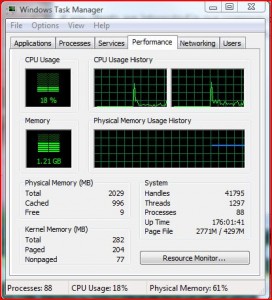Last month, I was invited to attend a four day training at Intel’s Hillsboro Oregon campus for a program that is called NPW (New Platform Workshop). Every time Intel comes out with a whole new platform, they select key partners to come and train on the new platforms. The new platform I received training on is code named “Nehalem” . The new Nehalem Microarchitecture is nothing like it’s predecessors. During my four day training, I received valuable training on power savings. Going green is nothing new to me, but actually seeing the power savings in front of my eye’s with actual proof is what made me a believer from a skeptic.
The new Nehalem based processors are designed for servers and higher end workstations. When new products such as this come out, they generally take the features and scale them down to the desktops within a matter of months. One example of what I saw to save energy was a comparison of the previous processors to the new one. On average, a previous generation based server would consume between 450 – 550 Watts on average. When we hooked up a new Nehalem based server to a power meter during our comparison, the average watts it was pulling was at 100 – 120 Watts. That is about a 80% savings in just power consumption. I thought, wow, if we can cut down the energy the servers pull, 24 hours a day, calculated over the life of an average server (3 -5 years) that can be a significant savings for our clients. But that was just the beginning of how we can save on energy with this new product. Another key benefit of the new architecture is speed. How can a server use less power and still remain at the same speed? Well with Nehalem it actually runs faster, I would say about 60% faster. I had to throw out everything I had been taught previously about processors and computing power. It was always alleged that the faster a processor’s MHz was, the faster the computer would run. This is not the case anymore. One of the key things that Intel did was move the memory next to the processor. By doing this, the processor talks directly to the memory, avoiding the bottleneck on current servers and workstations. This was a great design change because previously it was like having a Ferrari and only allowed to drive it on the 15 freeway at rush hour traffic. With this change, you could say that it was like having a Ferrari and having 100 lanes on that same freeway.
Another great thing about this new platform is that we can now truly take advantage of virtualization. I get asked a lot about virtualization, so for those of you who don’t know, let me explain. Virtualization allows you to take a physical server, and run multiple “Virtual” servers on top of them, each running independently of each other. Let’s use the Nehalem platform as an example. If we took a customer who say has 4 servers in their office, each consuming 500W of power (4×500 = 2000W) and virtualized them to one Nehalem based server, you would be consuming approximately 400W of power on average, which is a savings of 1600W of power. Do the math on that for 3 -5 years, and that is a huge power savings! You might ask how do you run 4 servers on 1 server and still get the performance of having 4 physical servers? On average, the processor in most current servers is very underutilized. An example of this is shown below:

What we see get’s most utilized is the memory and hard disks in a server. So if you have 4 servers sitting around, not using their processors, it makes sense to consolidate them into virtual servers to take advantage of what you paid for, the processing power. With the Nehalem processors, since the memory is sitting right next to the processor and has 100 lanes on the freeway for our Ferrari, you will get a major increase in performance in memory to those 4 virtual servers. Another savings you will get is the cost of parts and maintenance. If you have only one server to maintain for parts, you have less parts, which means less money you have to spend on maintenance.
If any clients are interested in our company coming out to do a power budget analysis on how we can help you save money, and help the planet as well, please let me know. It is free, and we can help save you money.

Recent Comments